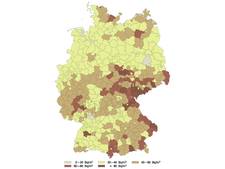-
Topics
subnavigation
Topics
Electromagnetic fields
- What are electromagnetic fields?
- Static and low-frequency fields
- Radiation protection relating to the expansion of the national grid
- High-frequency fields
- Radiation protection in mobile communication
Optical radiation
Ionising radiation
- What is ionising radiation?
- Radioactivity in the environment
- Applications in medicine
- Applications in daily life and in technology
- Effects
- What are the effects of radiation?
- Effects of selected radioactive materials
- Consequences of a radiation accident
- Cancer and leukaemia
- Genetic radiation effects
- Individual radiosensitivity
- Epidemiology of radiation-induced diseases
- Ionising radiation: positive effects?
- Risk estimation and assessment
- Radiation protection
- Nuclear accident management
- Service offers
-
The BfS
subnavigation
The BfS
- About us
- Science and research
- Laws and regulations
- BfS Topics in the Bundestag
- Links
Radon in buildings
- From the subsoil, radon reaches outside air and enters dwellings.
- The radon levels indoors depend on the formation of radon within the ground, the materials on the site, their properties relevant for radon transport, and the construction method.
- The annual mean value of radon concentrations indoors averages 50 Becquerel per cubic meter (Bq/m³).
- The actual levels of radon concentrations indoors can only be determined by measurements.

![]() Average radon levels (geometric mean value) in in buildings in Germany
Source: (according to Menzler et. al.)
Average radon levels (geometric mean value) in in buildings in Germany
Source: (according to Menzler et. al.)
The natural radioactive noble gas radon is constantly evolving in the geological subsoil. It is partially released into the air-filled pore spaces of rocks and soils. From the subsoil, radon reaches outside air and enters dwellings. The radon levels indoors depend on
- the formation of radon within the ground,
- the materials on the site, their properties relevant for radon transport, and
- the construction method.
Radon from the subsoil reaching the inside of a dwelling can expand further mostly via staircases, cable ducts and supply shafts, but also via floor slabs.
Radon concentrations
The radon concentrations measured in different studies cover a wide range. The annual mean value indoors averages 50 Becquerel per cubic meter (Bq/m³).
Elevated radon concentrations are more frequent in areas with increased radon levels in the soil air and radon-permeable subsoil. However, annual mean values exceeding 1,000 Bequerel/m³ indoors are rare even in such areas (Figure 1, Figure 2).

![]() Frequency distribution in buildings with 1 and 2 flats
Frequency distribution in buildings with 1 and 2 flats
Ventilation influences radon concentration
The radon concentrations are also influenced by the inhabitants’ particular room use and lifestyle habits - i.e. above all their ventilation behaviour. A change in room use can sustainably change the radon concentrations.
The actual levels of radon concentrations indoors can only be determined by measurements.
Radon - an important health problem
Radon is present in all dwellings, thus posing a major health problem. For rooms used more frequently than on a temporary basis, it is therefore required to keep radon concentrations as low as possible.
The amount of radon entering a dwelling with the outdoor air during air exchange and being released from building materials can hardly be reduced. It is therefore not generally feasible to reach radon levels below 100 Bq/m³ indoors in Germany. Such a situation is to be found in areas with increased radon concentrations in outside air and in dwellings with an above-average release of radon from construction material.
Measures to reduce radon concentrations should always be considered with levels exceeding 100 Bq/m³.
Protective measures
Proven measures for the protection from elevated radon concentrations for both new and existing dwellings have been compiled by the BfS in the "German Handbook on Radon". To request a copy (in German) please send an e-mail to info@bfs.de.
State of 2017.09.29


